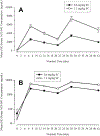A phase 2 study of dalantercept, an activin receptor-like kinase-1 ligand trap, in patients with recurrent or metastatic squamous cell carcinoma of the head and neck
- PMID: 27648727
- PMCID: PMC6901028
- DOI: 10.1002/cncr.30317
A phase 2 study of dalantercept, an activin receptor-like kinase-1 ligand trap, in patients with recurrent or metastatic squamous cell carcinoma of the head and neck
Abstract
Background: Patients with platinum-refractory, recurrent or metastatic squamous cell carcinoma of the head and neck (RM-SCCHN) have limited options. Activin receptor-like kinase 1 (ALK1) is a type I receptor of the transforming growth factor β superfamily expressed on activated endothelial cells. Dalantercept is an ALK1 receptor fusion protein that acts as a ligand trap to block signaling through ALK1 and inhibits stages of angiogenesis involved in blood vessel maturation and stabilization. In a phase 1 study, dalantercept demonstrated clinical activity in patients with RM-SCCHN. The objective of the current study was to evaluate the activity of dalantercept in RM-SCCHN.
Methods: Forty-six patients received dalantercept at doses of 80 mg (n = 2), 0.6 mg/kg (n = 13), or 1.2 mg/kg (n = 31) subcutaneously every 3 weeks. The primary endpoint was the overall response rate according to Response Evaluation Criteria in Solid Tumors (RECIST version 1.1). Secondary endpoints included progression-free survival and overall survival, safety and tolerability, and pharmacokinetic and pharmacodynamic assessments.
Results: Forty patients were evaluable for response (13 who received dalantercept 0.6 mg/kg and 27 who received dalantercept 1.2 mg/kg). The overall response rate was 5% (n = 2), and 35% of patients had stable disease; 44% of patients who received 1.2 mg/kg and 30.8% of those who received 0.6 mg/kg achieved disease control (partial response or stable disease). The median progression-fee survival was 1.4 months (95% confidence interval, 1.3-2.2 months), and the median overall survival was 7.1 months (95% confidence interval, 5.5-11.1 months). Drug-related adverse events (>15%) were anemia, fatigue, peripheral edema, headache, and hyponatremia.
Conclusions: In an unselected, heavily pretreated population of patients with RM-SCCHN, dalantercept monotherapy resulted in a favorable safety profile but only modest dose-dependent activity, and it did not meet the primary efficacy objective of the study. Cancer 2016;122:3641-9. © 2016 American Cancer Society.
Keywords: activin receptor-like kinase 1 (ALK1); angiogenesis; bone morphogenetic protein 9 (BMP9); dalantercept. squamous cell carcinoma of the head and neck (SCCHN).
© 2016 American Cancer Society.
Figures
Comment in
-
Antiangiogenic agents in head and neck squamous cell carcinoma: Tired of going solo.Cancer. 2016 Dec 1;122(23):3592-3595. doi: 10.1002/cncr.30352. Epub 2016 Sep 20. Cancer. 2016. PMID: 27649273 No abstract available.
References
-
- Siegel RL, Miller KD, Jemal A. Cancer statistics, 2015. CA Cancer J Clin. 2015;65:5–29. - PubMed
-
- Jemal A, Murray T, Ward E, et al. Cancer Statistics, 2005. CA Cancer J Clin. 2005;55:10–30. - PubMed
-
- Chung CH, Parker JS, Karaca G, et al. Molecular classification of head and neck squamous cell carcinomas using patterns of gene expression. Cancer Cell. 2004;5:489–500. - PubMed
-
- Sturgis EM, Ang KK. The epidemic of HPV-associated oropharyngeal cancer is here: is it time to change our treatment paradigms? J Natl Compr Canc Netw. 2011;9:665–673. - PubMed
-
- Vermorken JB, Herbst RS, Leon X, Amellal N, Baselga J. Overview of the efficacy of cetuximab in recurrent and/or metastatic squamous cell carcinoma of the head and neck in patients who previously failed platinum-based therapies. Cancer. 2008;112:2710–2719. - PubMed
Publication types
MeSH terms
Substances
Grants and funding
LinkOut - more resources
Full Text Sources
Other Literature Sources
Medical


